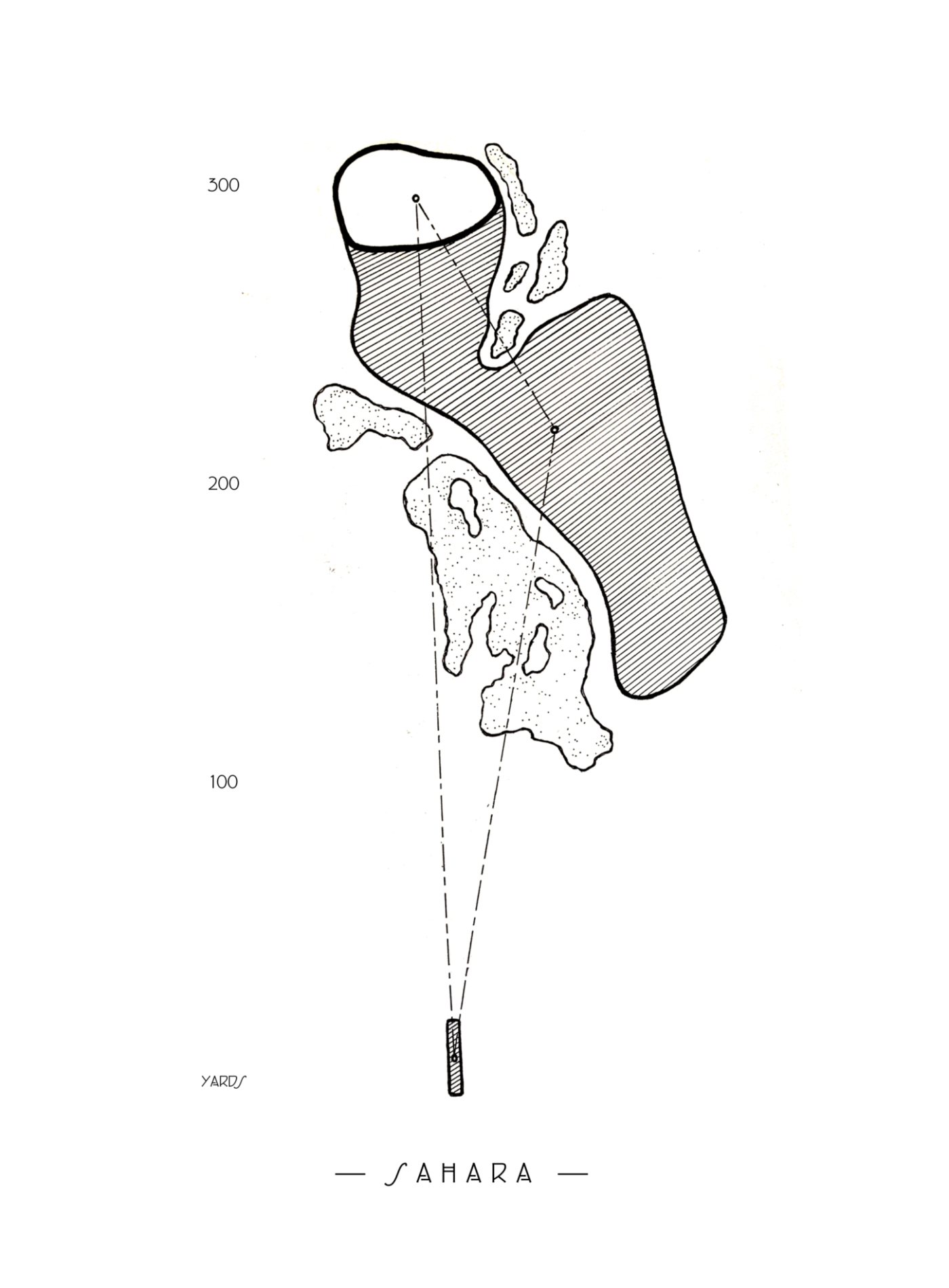In a two-part feature for Japan’s Golf Digest Choice magazine, Benjamin explored the remarkable contribution of C.B. Macdonald to the art of golf course architecture: template holes.

Alps, Eden, Sahara. To golfers these words are more than just geographical phenomena. They conjure images of ancient links courses in the British Isles; of blood-pumping golf course architecture. They are template holes and they have been replicated on hundreds of golf courses around the world. Their proliferation is the legacy of one pioneering American gentleman and his quest to build the ideal golf course.
In 1872 Charles Blair Macdonald sailed to Scotland for a three-year program of study at St Andrews University. He became enthralled by the curious game of ‘gowf’, around which town life seemed to revolve. Thanks to some coaching in golf and life from none other than Old Tom Morris, young CB became a proficient golfer. However, after returning to the States he would barely touch a golf club for 20 years. Early US golf architecture was a poor imitation of the rugged links game he remembered from his time in Scotland. Macdonald focused on growing his family fortune. By his mid-30s Macdonald was wealthy enough to dedicate his time and resources to lighting the touch paper under US golf. He convinced a group of Chicago friends to take up the game. Two years later they completed construction of the first 18 hole golf course in the United States. However, this original course was deemed substandard and the Chicago Golf Club would relocate to a superior site and complete its second 18 hole course in 1895.
CB’s familiarity with Scottish golf led him to resist the development of an American form of the game. He would help to found the USGA and ensure its close ties to St. Andrews. His endeavours as an architect would replicate the strategies and playing characteristics he remembered from his favorite holes in Scotland. Bold green and fairway contours and gaping sand hazards would make their debut in the United States.
In 1902, a few years after after relocating to New York City, the 46-year-old Macdonald embarked on a project which would cement his place in the pantheon of golf design legends. Macdonald’s ideal golf course would take shape at the National Golf Links of America.
An American Masterpiece
Macdonald set out his bold vision for National Golf Links in a ‘founder’s agreement’:
“Any golfer conversant with the golf courses abroad and the best we have in America – which are generally conceded to be Garden City, Myopia and the Chicago Golf Club – knows that in America as yet we have no first-class golf course comparable with the classic golf courses in Great Britain and Ireland. There is no reason why this should be so, and it is the object of this association to build such a course, making it as near National as possible, and further, with the object of promoting the best interests of the game of golf in the United States. With this end in view, it is proposed to buy two hundred or more acres of ground on Long Island, where the soil is best suited for the purpose of laying out a golf course…As to the building of the golf course, it is well known that certain holes on certain links abroad are famous as being the best considering their various lengths. It is the object of this association to model each of the eighteen holes after the most famous holes abroad, so that each hole would be representative and classic in itself.”
Between 1902 and 1906 Macdonald made annual trips to study and survey the ancient links of the British Isles. In hiring a surveyor to help him lay out his template holes Macdonald inadvertently formed one of the most impactful design partnerships in the history of golf architecture. The young Seth Raynor, who had never touched a golf club in his life, would eventually graduate from the role of Macdonald’s assistant to become a prolific architect in his own right.
In the rest of this feature Benjamin presents a fictional golf course comprised of his favorite template holes from the design portfolios of Macdonald and Raynor (MacRaynor is a commonly used portmanteau of their names). He discusses the origin and design concepts of each hole, and analyses the strategic merits which inspired Macdonald to immortalise them as part of his ideal golf course.
An Ideal Course?
A working knowledge of the playing strategies Macdonald identified for his ideal course amounts to a foundational program of study in golf course architecture. The inspiration for the templates is not always 100% clear but likely origins are denoted in brackets.
Out Course
In Course
- Knoll (Scotscraig)
- Narrows (Muirfield)
- Double Plateau (numerous)
- Redan (North Berwick)
- Lion’s Mouth (St. Andrews)
- Leven (Leven Links)
- Eden (St. Andrews)
- Channel (Littleton Old)
- Alps (Prestwick)
1. Bottle

Macdonald’s Bottle hole is an adaptation of the 12th hole on Sunningdale’s Old Course in England. Macdonald’s twist was to utilise Willie Park Jr’s quirky split fairway for the tee shot instead of the second shot.
Strategy: Macdonald’s bottle template offers a simple proposition to the golfer: will you play for the narrow left fairway to secure a more direct line to the pin, or will you play for the wider fairway on the right, leaving a more difficult approach to the green? The left fairway accepts a left-to-right shot, whereas the right fairway is more welcoming to the reverse. For golfers who can shape the ball in either direction the decision comes down to feel and wind conditions.
Comments: Macdonald’s re-imagining of Sunningdale Old’s 12th hole was a masterstroke. Willie Park Jr’s original presented a stout challenge in the era of hickory play, when the split fairway would typically have received the second shot of a three-shot hole. Moving the decision to the tee shot updated the bottle concept for the golden age.
2. Biarritz
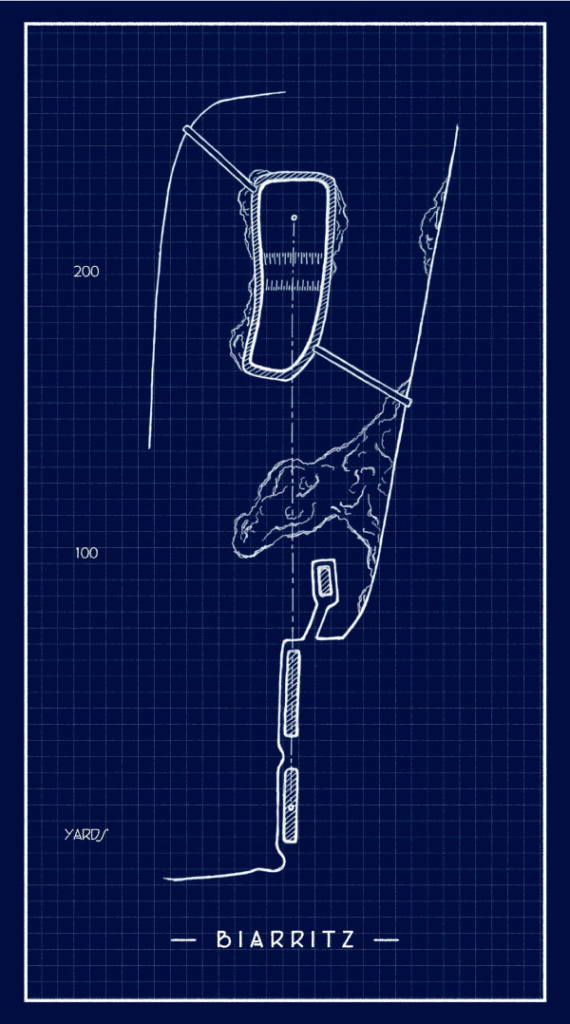
Biarritz green complexes are found on virtually every course in the MacRaynor portfolio—with the notable exception of National Golf Links of America. This type of green originated in France and Scotland, with the concept perfected by North Berwick-born greenkeepers Tom and Willie Dunn.
While working in Scotland the younger Dunn brother built a raised two-section green that was oriented diagonally to the fairway and featured an abrupt swale perpendicular to the line of play. Dunn’s green is celebrated and despised in equal measure to this day. Shortly thereafter the two brothers collaborated on a long par three version that played over the ocean to a rocky outcrop high above the Bay of Biscay in South-western France. Biarritz Golf Club’s famous ‘Chasm’ hole is no more but its architectural concept was immortalised by Macdonald and lives on in the majority of his designs.
Strategy: the classic Biarritz presents the golfers with a straightforward problem: do you fly your approach shot over the swale or land short and run your ball into the swale and back up the other side, with enough momentum to come to rest on the back plateau. It is a shot which demands a delicate touch and a powerful stroke. The hole built by Tom Dunn in Biarritz would have required the golfer to perfectly control the length and trajectory of full-blooded stroke with a brassie (2-wood). This was not a shot for the faint of heart.
Comments: Perfect execution of a ground shot through a Biarritz swale is one of my favourite things to do in all of golf. As a young caddy at North Berwick I would take great pleasure in my customers experiencing this wildly unique green for the first time. I would offer them a little coaching about line and pace and before watching them experiment with putts and running approaches that entered the swale and either ran true to the back plateau or were rejected out through the sides of the swale. Fun!
3. Hog’s Back
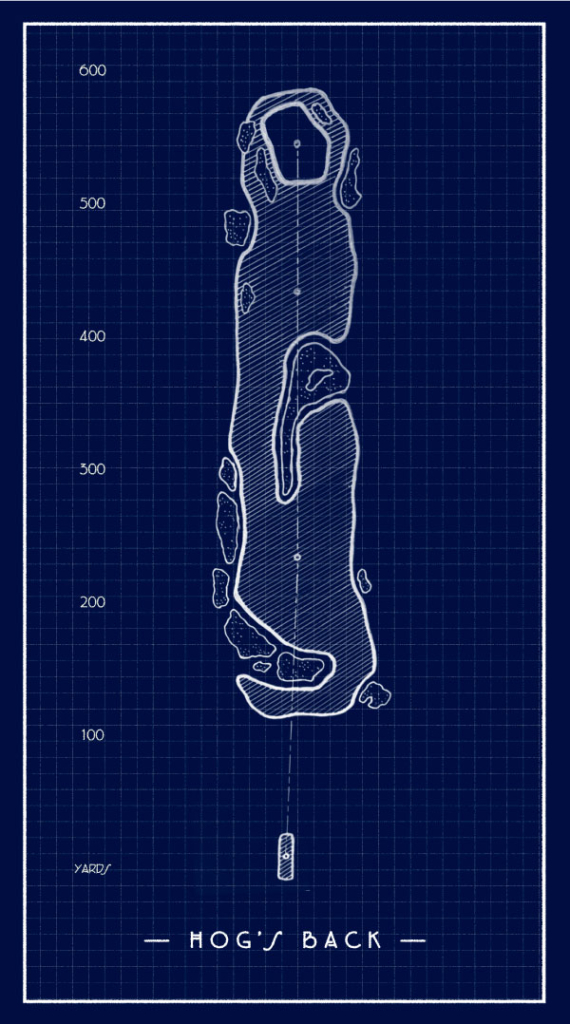
A simple concept which Macdonald and Raynor applied to fairways (and occasionally greens) throughout their portfolio of work. Hog’s back fairways can be found on numerous links courses in the British Isles. On MacRaynor versions the golfer is asked to accurately land their tee shot on a broad, domed contour that sheds poor strokes into the surrounding hazards. While the fairway appears for the tee to be perfectly domed there’s actually a generous landing strip in the middle.
Strategy: A classic Hog’s Back might—more than any other type of fairway feature—demand a tee shot living up to the ’far and sure’ motto which was a rallying cry for golfers in C.B. Macdonald’s era. The proposition is simple: can you make the shot?
Comments: I consider the bold and simple elegance of a Hog’s Back fairway to be one of the most attractive visuals in all of golf. The feeling that nothing less than a rifle-straight drive will suffice is truly memorable, even though in practice these fairways and greens are more forgiving than they appear.
4. Road
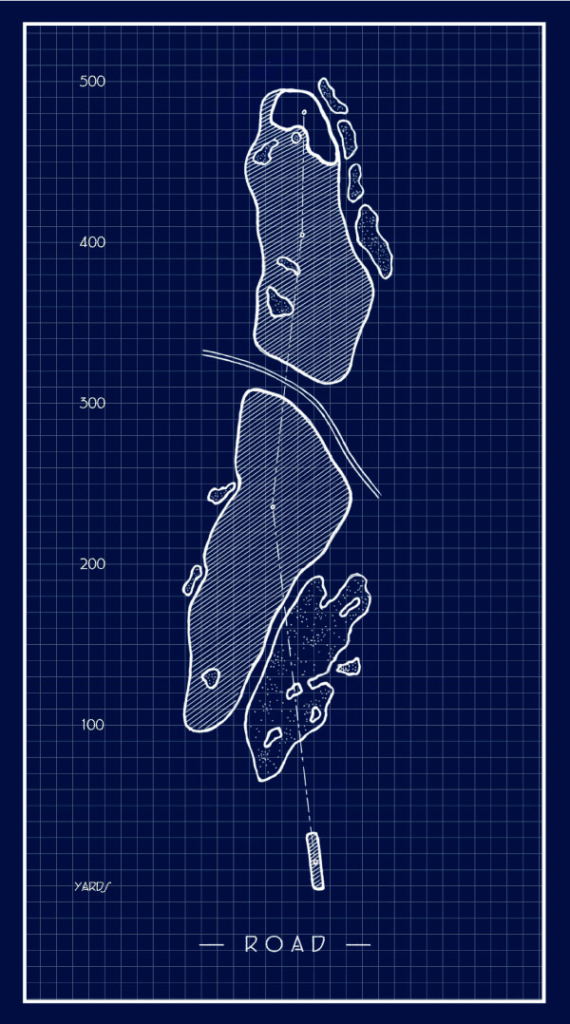
One of the most obvious template candidates at the Old Course in St Andrews. The legendary Road Hole is a test of the player’s understanding of geometry and their ability to execute a long and accurate drive followed by a long approach shot. MacRaynor Road templates usually play as a long par four or a short par five. All boast a fearsome Road Hole bunker. An actual road is occasionally part of the design, but in most cases Macdonald and Raynor simulated this feature using bunkers.
Strategy: Little thought is required on the tee as anything less than a perfect tee shot on an aggressive line will prevent the player from reaching the middle and back sections of the green in two strokes. The safer the line from the tee the tougher the second shot becomes. Indeed, the golfer who finds themselves well out of position on the left side of the fairway must play a thirty-yard hook to have any chance of their ball climbing onto the front section of the green, versus spiralling away into the treacherous road hole bunker or careening straight over the green onto the waiting road.
Comments: A Road Hole template features in many MacRaynor designs but rarely features all key elements found on the original hole in St. Andrews. The OB on the right side of the original hole makes it a fearsome challenge, but the eponymous road tucked right behind the green is the standout feature of the hole.
5. Short
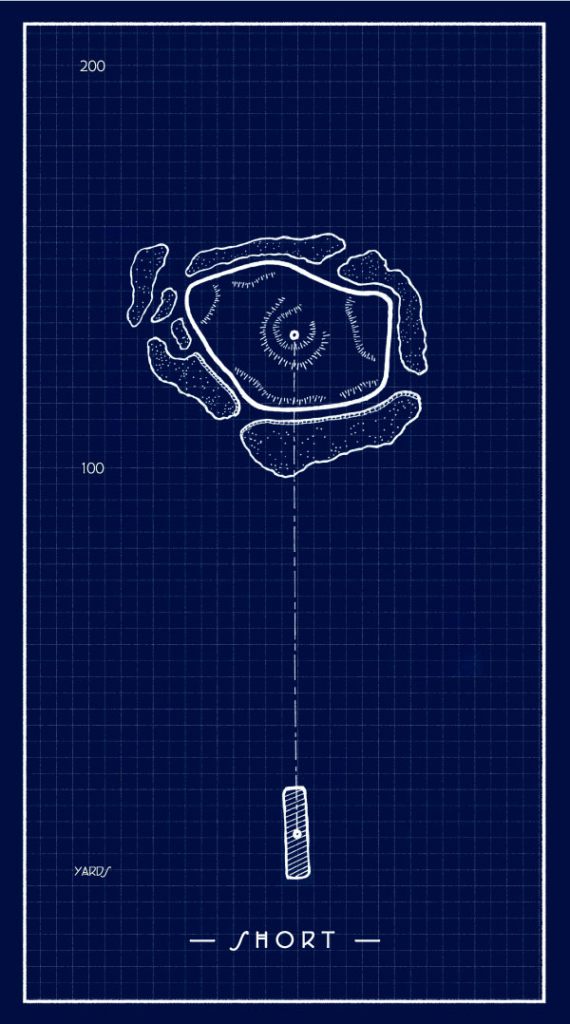
A par three designed to first test a player’s nerve and accuracy with a short iron, and then with their putter. This template typically features a huge undulating green that is elevated high above deep surrounding hazards. It featured in virtually every MacRaynor design. But finding this green is no guarantee of a regulation two putt. Navigating the internal contours of a short template requires care and attention.
Strategy: Do not miss the green!! The trouble that surrounds it is truly horrendous. Hitting the correct section is essential. On many Short templates a putt from above the hole is impossible to stop. For any ball that comes to rest in the wrong section of the wildly undulating green a three put is a good result.
Comments: The heavily fortified 5th (now the 4th) at Brancaster is instantly recognisable due to the wall of railway sleepers fronting the green. The overall look has changed little since Macdonald’s day but the green contours have been softened. Indeed, Brancaster’s short hole was the origin of the ‘thumbprint’ feature that Macdonald used in so many of his greens. At some point Brancaster decided to remove their thumbprint, but numerous MacRaynor greens still employ this feature.
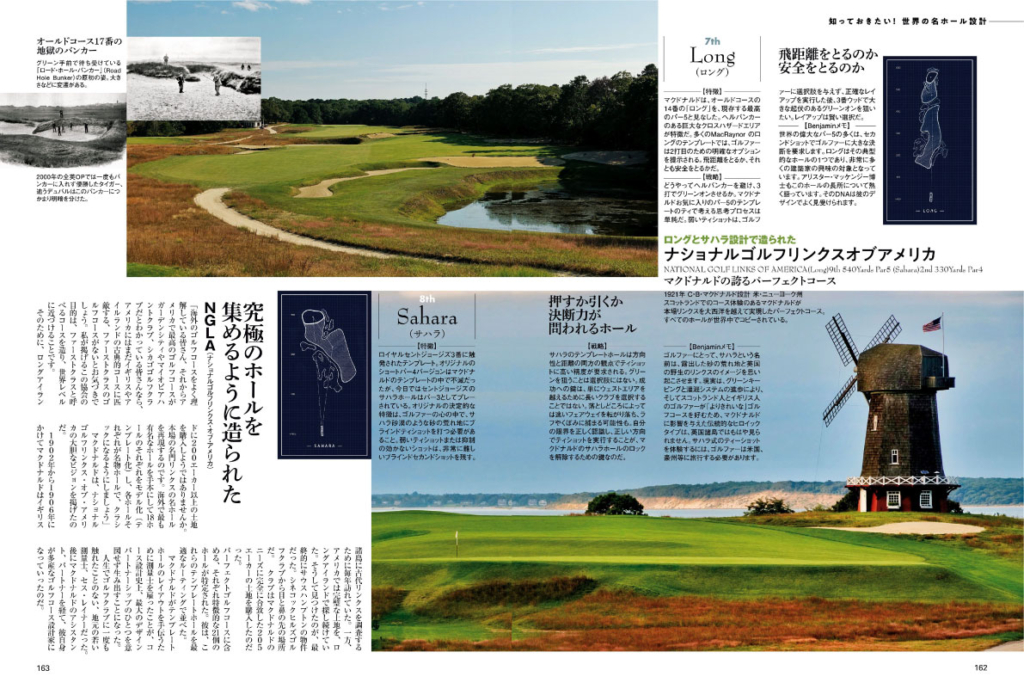
6. Punchbowl
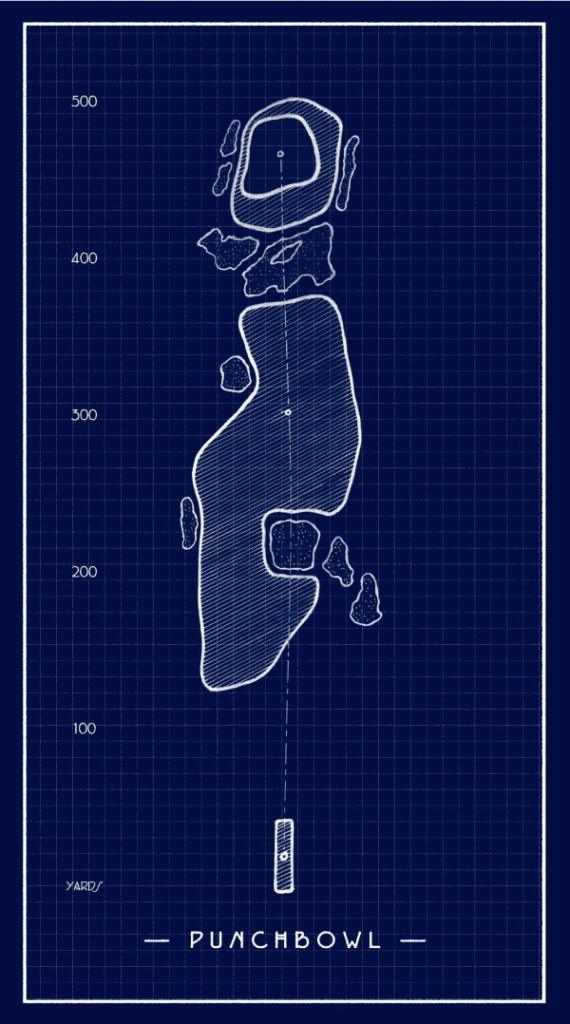
A par four inspired by the punchbowl-style greens found on many of the ancient links in Scotland and England. In sandy soils these low-lying greens drain well but retain enough moisture to sustain grass of the highest quality. Punchbowls were popular with game’s earliest designers and virtually every MacRaynor course featured a version of this template.
Strategy: The approach is blind but shots gather into the green from surrounding slopes. Due to the forgiving nature of the green complex the tee shot on a MacRaynor punchbowl is often a test of pure execution. Offline tee shots are punished but the real challenge is to resist the urge for an overly aggressive recovery shot to the receptive green. The penalty for coming up short can be severe and your third shot will still be blind.
Comments: Some courses featuring punchbowl greens offer the golfer a chance to memorize the pin position from a vantage point earlier in the round. On Macdonald’s NGLA the forward-thinking golfer will make a mental note of the pin position on the punchbowl 16th as they leave the 2nd green.
7. Long
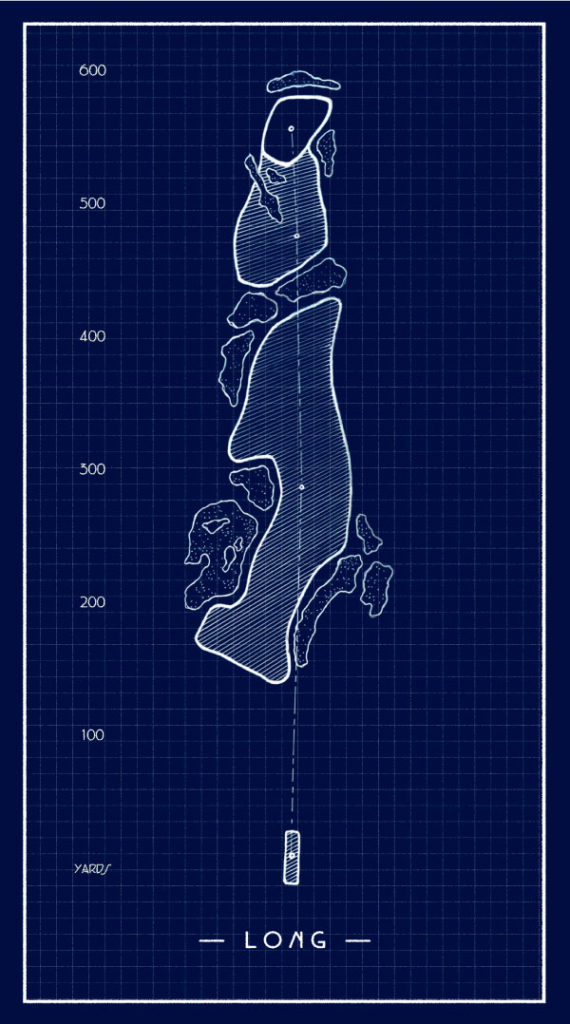
Macdonald considered the 14th at St Andrews Old Course “Long” to be one of the greatest par fives in existence. The defining characteristic of the hole is a gigantic cross hazard area featuring a Hell bunker. On many MacRaynor Long templates the golfer is presented with two clear options for their second shot: take on the carry or play for position short of the hazard. The original Long at the Old Course offers the option to play around the cross hazard. In the extremely windy weather conditions of St Andrews this is essential. Macdonald’s interpretations were typically on sites with less ferocious winds, hence the limited options.
Strategy: How does the golfer avoid Hell bunker and earn a chance of reaching the green in three strokes?! The thought process on the tee of Macdonald’s favorite par five template is simple: a weak tee shot might leave the golfer with no option but to execute a precise lay-up followed by a well-struck three wood to a large undulating green. Make sure you get your tee shot away!!
Comments: Many of the world’s great par fives demand a big decision from the golfer on the second shot. Long is one such hole. It remains an object of affection of many golf architects.
8. Sahara

Inspired by the third at Royal St. Georges. The original short par four version has been immortalised among Macdonald’s templates but today the Sahara hole at St. Georges plays as a par three. The defining characteristic of the original was the blind tee shot over a sandy wasteland which, in the mind’s eye of the golfer, takes on Sahara-esque proportions. A weak tee shot or one that lacks distance control will leave a very challenging blind second shot.
Strategy: Sahara template holes demand precision from the tee—both in terms of line and distance control. Driving the green is rarely an option. The key to success is not to simply hit your longest club to make sure that you carry the sand. A ball that runs too far on landing can roll through the elevated fairway and down into a grassy hollow that is blind and leaves little hope of making par. An understanding of one’s limitations from the tee, and an ability to execute the right shot on the right line, is the key to unlocking Macdonald’s Sahara hole.
Comments: For golfers the name Sahara conjures images of wild British links with exposed sandy wastelands. The reality is that due to advances in greenkeeping and irrigation systems—and the preference of Scottish and English golfers for ‘tidier’ golf courses—many of the heroic carries over sandy wastelands which inspired Macdonald have been grassed in. Bring them back!
9. Cape
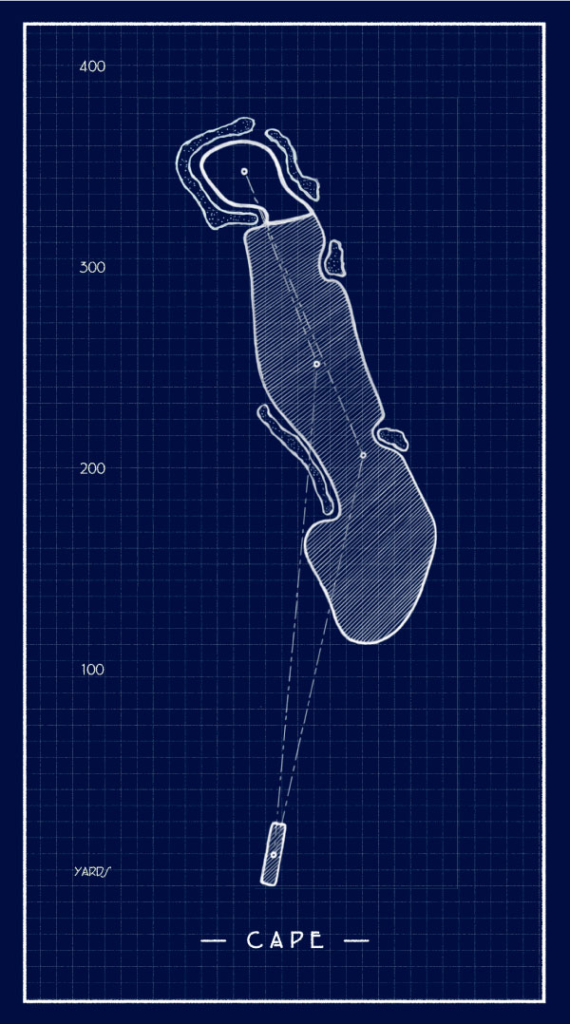
A C.B. Macdonald original short par four! A tee shot over a diagonally-oriented hazard is a recurring feature in classic architecture. Macdonald’s original Cape hole required the aggressive player to carry the same water hazard twice en route to a terrifyingly situated green.
Strategy: This pure risk-reward template encourages shot-shaping and rewards a brave line from the tee with a shorter shot and a realistic angle to a green that is surrounded by water on two or three sides.
Comments: Diagonal carries are a foundational element of inspiring golf course architecture. Macdonald was familiar with holes like Brancaster #8, which invite the golfer to ‘bite off’ diagonal carries in order to create a better angle for the following shot. The key to the approach shot on a Cape hole is to play to the centre or right of the green and use the back board. Don’t be tempted to aim for a flag tucked against the water! Sadly Macdonald’s original cape hole at NGLA was redesigned to combat technological advances and to accommodate a road.
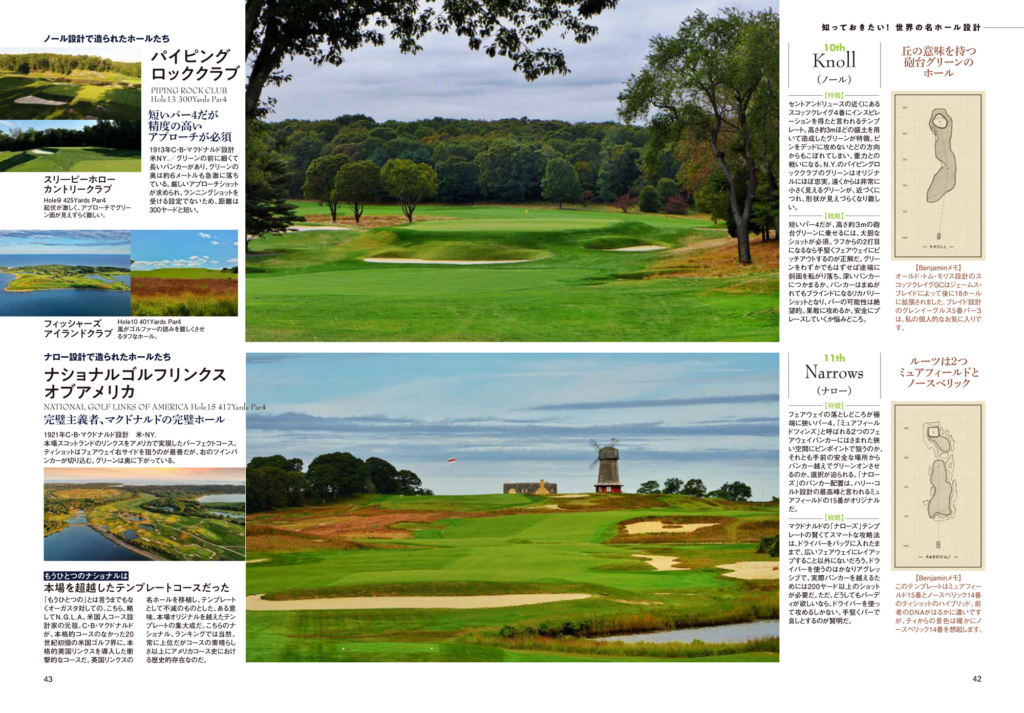
10. Knoll

Gravity is the defence of the knoll hole. On this template a green perched high above the fairway repels weak shots on all sides. The fourth hole at Scotscraig Golf Club in Fife is thought to have inspired CB Macdonald’s Knoll. Indeed, the raised plateau green at Piping Rock Club in New York—and specifically its hard-to-access back tier—is virtually identical to the Scotscraig version, with which Macdonald would have been familiar. When viewed from distance the knoll green seems impossibly small. As the golfer moves closer the proportions of the green do not become any more generous!
Strategy: Macdonald and Raynor used their Knoll template for short par fours. Piping Rock, Lido and Yale each have notable examples. On each version the golfer must play a bold stroke to hold a green surface that is sharply elevated eight to ten feet above the fairway. An out-of-position tee shot makes laying up for a pitch and putt par the smart play. Shots that narrowly miss the green will tumble down the closely mown surrounds or find deep bunkers, leaving blind recovery shots and a low chance of par.
Comments: The original Old Tom Morris design at Scotscraig was extended to 18 holes by James Braid. The knoll became a template hole for Braid and he would use it in many of his designs. Braid’s par three fifth at Gleneagles is one of the author’s personal favorites.
11. Narrows

At least once in every truly great round of golf the protagonist is called upon to hit one straight between the uprights! CB Macdonald’s ‘Narrows’ template is, from the tee, a straightforward proposition. The golfer can try to hold their nerve and thread the needle between pinching fairway bunkers known as the ‘Muirfield Twins’, or play for a shorter position and face a long second. The longer your tee shot the narrower the fairway becomes. The location of the ‘Narrows’ bunkering at National Golf Links is authentic to the wonderful 15th at Muirfield, one of Harry Colt’s finest golf holes, but huge scale makes the fairway feel even smaller than the punishing original in Scotland.
Strategy: The smart play on Macdonald’s ‘Narrows’ template—and their common ancestor at Muirfield—is to leave driver in your bag and lay up before the neck in the fairway. The cumulative impact of finding sand off the tee makes a large number a very real possibility. A tee shot positioned just short of the neck leaves and face a longer second that must barely carry the cross bunker in order to pull up in time to hold the green.
Comments: Interestingly Macdonald himself noted that the hole is a hybrid of the 15th at Muirfield and the tee shot of the ‘Perfection’ hole at North Berwick. The DNA from the Honorable Company’s home course is much more in evidence, but the death-on-all-sides tee shot does evokes #14 at North Berwick.
12. Double Plateau
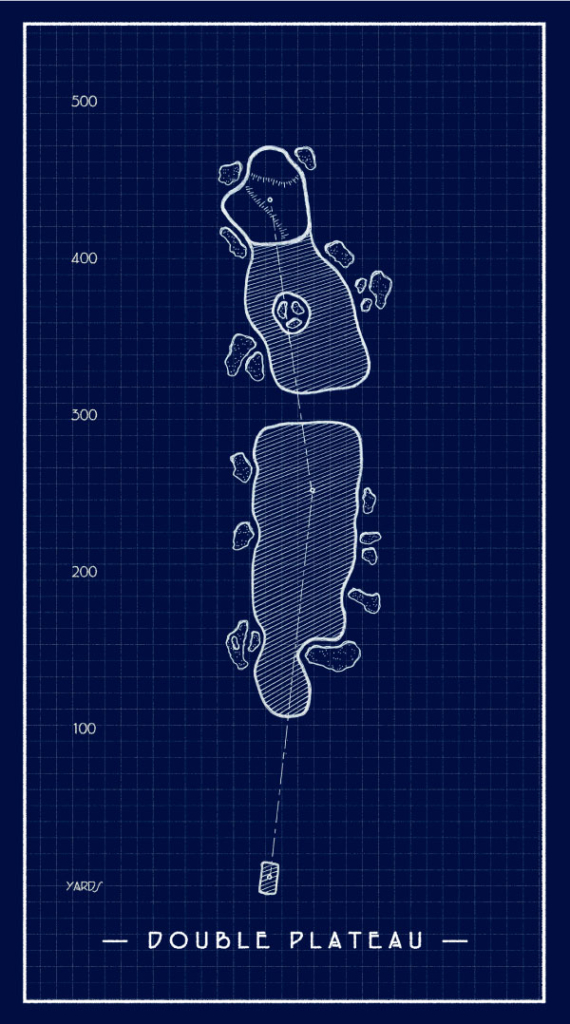
Greens defined by abrupt elevation changes and plateaus are found throughout the ancient links courses of the British Isles. A ‘double plateau’ green features three large distinct levels which are all pinnable. Macdonald was clearly enamoured with this feature and it is present in almost every golf course that bears either his or Raynor’s names. Double plateau greens were utilised almost exclusively on long two-shot holes. Greenside bunkering could be minimal but a ‘principle’s nose’ bunker guarded against a running approach played for position short of the green.
Strategy: Distance control. Distance control. Distance control. Did I mention distance control? With significant elevation changes between plateaus a two putt is realistic only form the correct level. Walking away with a par or better rests 100% on the quality of the approach shot.
Comments: Any golfer who doesn’t take a few extra minutes to hit putts between the levels of a double plateau green should probably take up a different sport. These are some of the most fun putting greens in the game of golf.

13. Redan
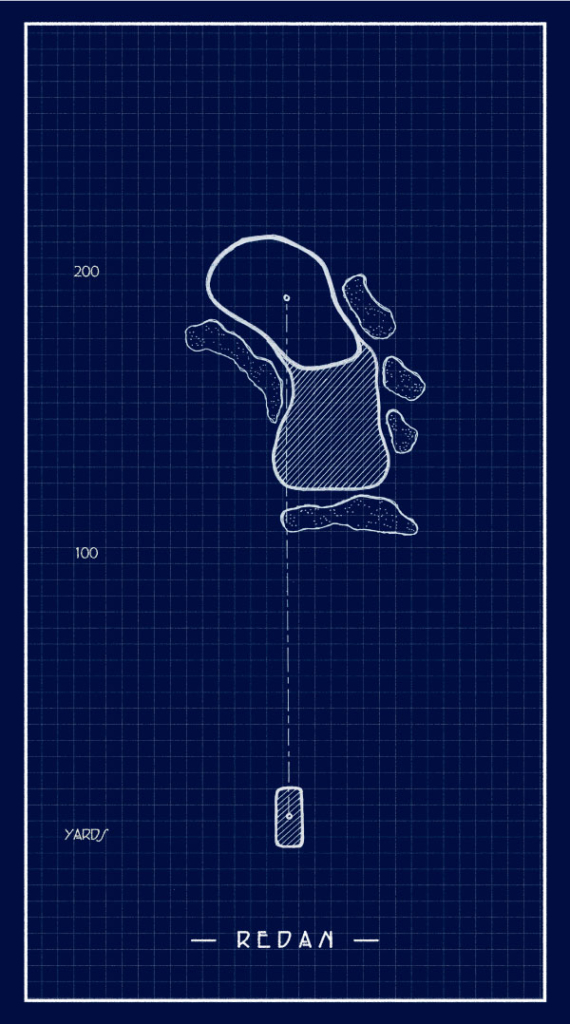
When CB Macdonald was studying at St Andrews University the famous Redan hole at North Berwick was actually a short par four. Golfers would place their drives short of large cross bunkers and pitch up to the elevated green. The line of play crossed North Berwick’s fourth hole. When Macdonald returned to survey British golf’s most famous holes in the early 1900s North Berwick’s huge popularity meant that crossing holes had been abandoned due to pace of play and safety concerns. Accordingly North Berwick’s 4th and 15th holes had both been shortened from par fours to par threes. If Macdonald’s survey trip had taken place a few years earlier America might never have been introduced to the legendary Redan hole, one of the most fearsome, and certainly the most copied, par threes in golf course architecture.
Strategy: Variable winds are the critical factor at all classic links courses. The nature of a Redan hole is that long and left of the green if safe. Indeed, when the hole plays downwind the smart strategy is to miss the green long with one’s teeshot. Chipping back up the green and trying to hole a putt leads to many well-earned pars. The alternative: coming to rest in the huge bunkers short or right of the green makes a par three all but impossible. Getting a completely blind bunker shot on a fallaway green close enough for a chance at par is all but impossible. Getting close enough for a birdie chance demands precise and delicate shotmaking. A high right-to-left approach which lands on the small shoulder contour at the front right of the green will feed into the green center.
Comments: “Take a narrow tableland, tilt it a little from right to left, dig a deep bunker on the front side, approach it diagonally and you have a Redan.” CB Macdonald’s description sums up this simple but powerful design concept with one small omission: the green on a Redan hole also tilts from front to back.
14. Lion’s Mouth
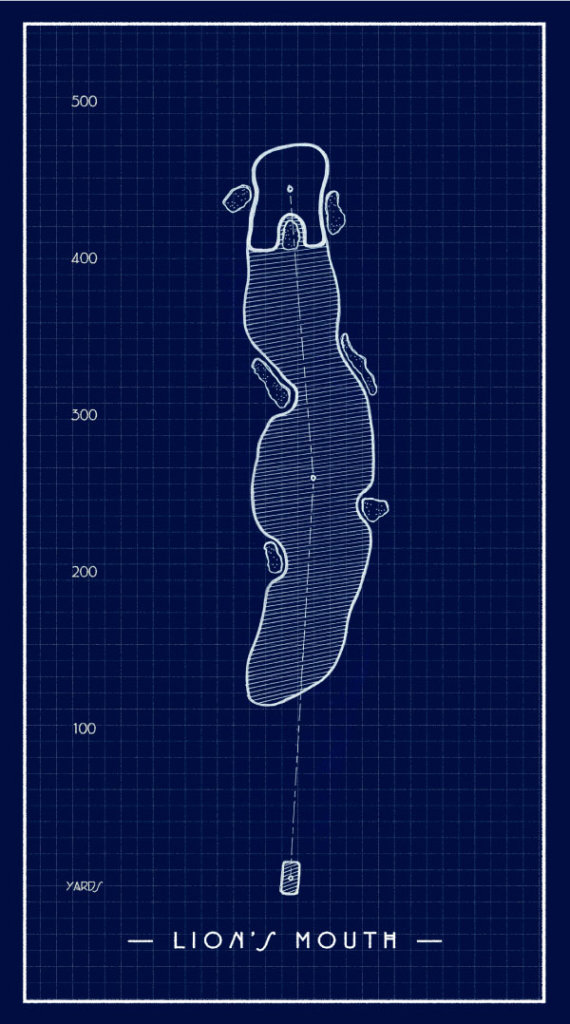
Seth Raynor never set foot in Scotland but his outstanding contribution to the MacRaynor templates was inspired by one of the many famous bunkers at the Old Course in St Andrews, which he would, with a large degree of certainty, have learned about from his opinionated mentor. The original Lion’s Mouth, from its location forty yards short of 13th green, has swallowed timid second shots for hundreds of years. However, the bark of that bunker is worse that its bite. The pivotal feature of the 13th at the Old Course is actually a rough grass swale that cuts into the front-centre of the putting surface to catch weak approach shots. Raynor’s Lion’s Mouth template moves the bunker into the position of the rough grass swale.
Strategy: The Lion’s Mouth poses a straightforward challenge. A sand save from the deep bunker is unlikely. This should be avoided at all costs. For left pins an approach from the left is preferable. For right pins favour the right side of the fairway. At the highest level of the art form golf architects find ways to make the same hole play differently based on the location of the pin. The fearsome Lion’s Mouth demands a a golfer think carefully when they stand on the tee over 400 yards away.
Comments: At the Country Club of Charleston and Fox Chapel in Pennsylvania Raynor perfected his Lion’s Mouth template. Thanks to repeated use by the Coore & Crenshaw design firm this template is enjoying a surge in popularity in the modern game.
15. Leven
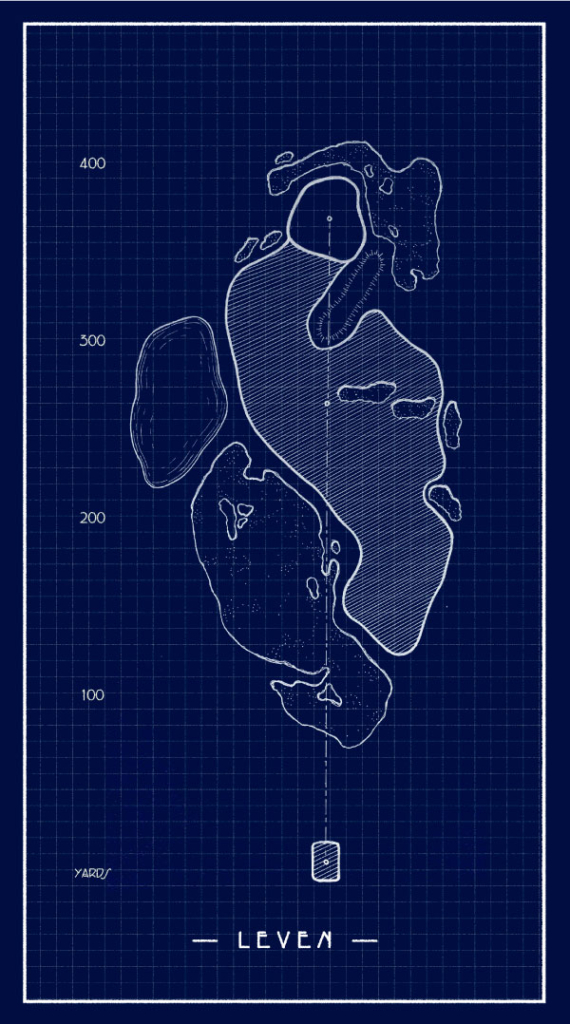
When earthmoving machinery became a feature of golf course construction blind shots became scarce on new golf courses. Golfers expected to see their target. Concepts like the Leven template, however, remain palatable in the modern era. The tee shot at the original hole in Scotland is defined by a creek which makes an elegant diagonal sweep across the fairway. Long hitters have an advantage but there is enough risk to keep them honest. Macdonald’s template uses a sweeping diagonal fairway to offer the golfer a wider choice of line from the tee.
Strategy: This hole is a perfectly formed example of heroic golf course architecture. From a tee high on a broad landform the golfer surveys a fairway around one hundred yards wide. The green is largely visible. The boldest line from the tee, a long carry over a sandy waste area, leaves perfect visibility for the second shot. The further right the golfer plays, the more their second shot is obscured by the dune in front of the green.
Comments: The course Mackenzie played when he discovered this hole no longer exists. Innerleven Golf Club was founded in 1820 but lost part of its course to a railway construction project and ended up contributing holes to two eighteen hole golf courses that exist today: Leven Links and Lundin Links. Fortunately for those who care about the history of golf course architecture the Leven hole that Macdonald immortalised can be played to this day.
16. Eden

‘Two or ten!!’ The Eden hole at St Andrews Old Course has long been considered the best short hole in the British Isles. That praise, however, is typically followed by the caveat “is it fair?”. Holes that drive passionate discussion over hundreds of years clearly have merit. The St Andrews Eden features no more than a handful of pin positions. Wild internal contours and strong winds have been known to redirect putts into the cavernous ‘Strath’ bunker that sits at the front and centre of the green. The MacRaynor Eden was typically softer than the original although it faithfully recreated the bunker arrangement and pin positions.
Strategy: There’s no escaping the fact that you must make a good swing at the Eden. The golfer choosing a conservative route has little chance of carding a regulation par three. Only the boldest and purest of strokes will find the heart of the putting green. Anything else invites a potentially large score.
Comments: The Eden green and its relationship to the surrounding bunkers was considered ‘on the edge’ in Macdonald’s day. With modern agronomy and machinery the Eden became so edgy that it was softened shortly before the 2015 Open Championship. Among the architecture cognoscenti this was not a popular decision!
17. Channel
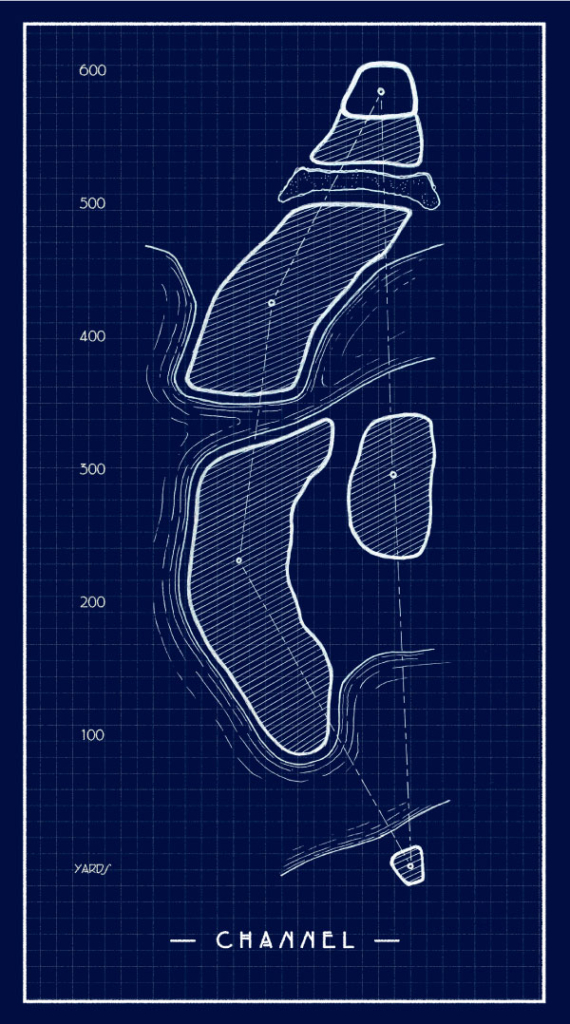
This enigmatic template didn’t grace many MacRaynor courses—perhaps due to very specific geographic requirements—but is ideal for the home stretch of our perfect golf course. Macdonald was introduced to the original at Littlestone Golf Club in Kent, England. Paradoxically the most famous rendition he built—at the Lido Golf Club on Long Island, NY—no longer exists. That stout three-shotter was manufactured in one of the most ambitious construction projects of golf’s ‘golden age’. 2,000,000 cubic yards of sand was dredged out of a neighbouring channel to build a completely new landscape, in 1916!!
Strategy: The key feature of the Channel hole is an alternate island fairway which powerful golfers can use to reach the green in two shots.
Comments: For a Channel hole to be truly engaging the alternate fairway must be a realistic option for reasonable golfers who are feeling confident. The three shot route must be significantly longer.

18. Alps

Prestwick’s contribution to Macdonald’s ideal course is one of quirkiest holes in world golf. The second shot on this long par four template is completely blind. Anyone who can’t carry the huge dune and the ‘Sahara’ bunker that waits beyond it—or are seriously out of position from the tee—are advised to take their medicine, lay up in the fairway and pitch over the dune with their third shot. Remarkably the 17th at Prestwick is virtually unchanged from the hole that Old Tom Morris and Willie Park Sr. played in the 1860s while competing for the Open Championship using hickory clubs and gutta percha balls. This stout two-shotter and its famous blind second featured in numerous MacRaynor designs.
Strategy: There’s no way to navigate an Alps hole without gambling! But do you prefer blackjack or roulette? Launching a long second shot blindly over the dune and trying to get up and down from the ‘Sahara’ bunker invites a potentially large number. Laying up in the fairway might increase your chances of finding the green with your third and having a guaranteed shot at par.
Comments: Enjoyment of the whimsical Alps hole—and appreciation of its historical value—is an indicator of the true golf architecture fan.
The Evangelist of Golf, by George Bahto
Every student of golf course architecture owns or aspires to own a copy of the remarkable Evangelist of Golf.
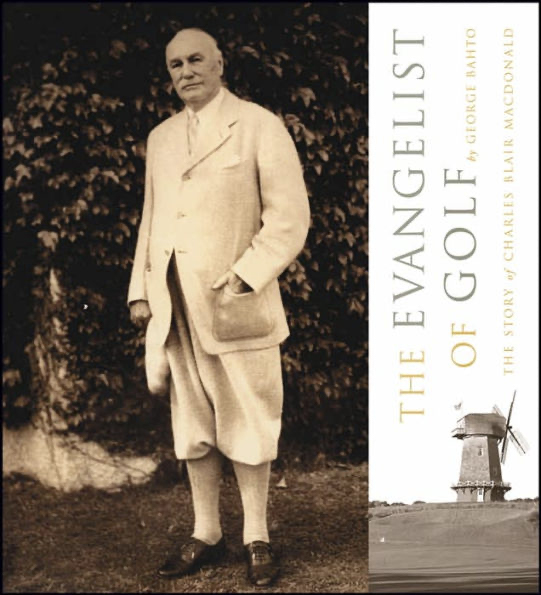
By day author George Bahto ran a dry cleaning company in Montclair, New Jersey; by night he became a self-educated expert on the golf course architecture of CB Macdonald and Seth Raynor. After spending decades immersed in the archives of the legendary clubs of New York State, Bahto compiled an impressive array of vintage photographs, detailed course layouts, and sketches of many of the most highly regarded MacRaynor template holes. Tracking down a pristine copy of Bahto’s masterpiece is on the to do list of every golf architecture fan.

